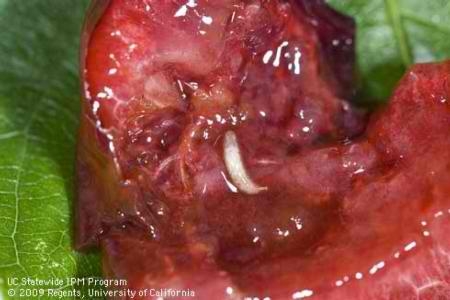Yeast discovery may lead to better lure to detect fruit fly
|
A certain species of yeast that UC Davis researchers found in “almost all” their samples of raspberries and cherries infested by the spotted-wing drosophila (Drosophila suzukii), may lead to a better lure to detect the invasive pest in the field. A research team from the UC Davis Department of Entomology, the Department of Food Science and Technology, and a visiting professor from the University of Extremadura, Spain, found that the yeast, Hanseniaspora uvarum, appeared in just about every cherry, raspberry and larva of the spotted-wing drosophila (SWD) that they sampled at collection points in Davis, Winters and Watsonville. The agricultural pest, native to southeast Asia and now found in many parts of North America, was first observed in California in the fall of 2008 in the central valley, but was not identified until early 2009. It is reported to attack soft-skinned, ripening fruits, and has been a particular problem for raspberry and cherry growers in California. The research team – composed of Phaff Yeast Culture Collection curator Kyria Boundy-Mills of the UC Davis Department of Food Science and Technology; Frank Zalom UC Cooperative Extension specialist in the Department of Entomology at UC Davis and integrated pest management expert; doctoral student Kelly Hamby in the Zalom lab; and UC Davis visiting professor Alejandro Hernandez of University of Extremadura, Spain – published their work in a recent cover article of the journal Applied and Environmental Microbiology, the No. 1 cited journal in microbiology. "This represents the first look at potential yeast associations of Drosophila suzukii," said Hamby. “Often Drosophila have interactions with yeast communities, and communities often vary between host plant species, so it was a bit of a surprising that we found Hanseniaspora uvarum so often, though, we used only culture-based methods so other yeasts may be present that are hard to culture,” Hamby said. Hannah Burrack, a former Zalom lab graduate student (now an assistant professor and Cooperative Extension specialist in the Department of Entomology, North Carolina State University) originally found that olive flies were more attracted to yeasts that were isolated from the flies themselves than to the Torula yeast bait that is commercially available for olive fruit fly management, Hamby said. In their journal article, the authors wrote that “D. suzukii is unique in that it oviposits on marketable fruit relative to overripe or damaged fruit, and its injury facilitates colonization by other Drosophila species. If untreated, it is capable of causing a potential $860 million of revenue loss annually to blackberries, raspberries, and cherries in California, Oregon, and Washington. Knowledge of potential yeast associations could be used in lure development.” Zalom said the pest is a major problem in the area for backyard cherries. “Many residents have not been able to harvest cherries for several years now.”
|

